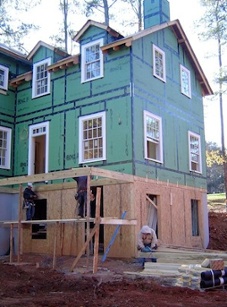ENERGY STAR 2011 – Version 3 of the New Homes Program

I’ve just finished going over the newly released ENERGY STAR 2011 guidelines for new homes and, as you might expect, I’m happy about some of the new requirements and disappointed/perplexed about others. Overall, though, the  program is moving in the right direction, which it must because building codes (specifically IECC 2009) keep pushing forward.
program is moving in the right direction, which it must because building codes (specifically IECC 2009) keep pushing forward.
I’ve just finished going over the newly released ENERGY STAR 2011 guidelines for new homes and, as you might expect, I’m happy about some of the new requirements and disappointed/perplexed about others. Overall, though, the program is moving in the right direction, which it must because building codes (specifically IECC 2009) keep pushing forward.
Here’s what’s new, compared to version 2 of the program, which was released in 2006:
- Size matters – Big houses get penalized!
- 4 checklists instead of just 1
- An individual HERS Index for each home to qualify, based on the ENERGY STAR Reference Design
When I became a certifed home energy rater in 2004, I asked David Lee of the EPA why they let giant houses qualify for the ENERGY STAR label. Yeah, I’m very familiar with the stock answer – these homes are going to get built, so why not help make them efficient. But I’ve always had a problem with ENERGY STAR qualified homes that are 10,000 or 20,000 square feet.
Finally, though, with version 3, ENERGY STAR has acknowledged that larger houses should have to work harder to get that label. They do that with what they call the ENERGY STAR Benchmark Home. The 1 bedroom Benchmark Home is 1000 square feet. It’s an additional 600 square feet for each additional bedroom (1600 square feet for 2 bedrooms, 2200 for 3…). If the rated is bigger than the Benchmark Home, it’s got to achieve better performance than if it were the same size or smaller.
Another change in the ENERGY STAR New Homes program is that there are now four checklists to be completed. Version 2 of the program introduced the first checklist: the Thermal Bypass Checklist. Now that checklist has expanded and become the Thermal  Enclosure System Checklist, to be completed by the certified home energy rater. It now includes thermal bridging in addition to the insulation and air sealing items.
Enclosure System Checklist, to be completed by the certified home energy rater. It now includes thermal bridging in addition to the insulation and air sealing items.
Heating, cooling, and ventilating systems have been perhaps the biggest hangup in qualifying houses. I just rejected a home this week, as a matter of fact, because the cooling systems were oversized. So now there are two checklists for HVAC (heating, ventilating, & air conditioning). One will be completed by the HVAC contractor and the other by the home energy rater. It’s not ideal, and a completed checklist doesn’t mean that the systems are all done correctly, but it’s a step forward from where we’ve been.
The final checklist – the Water Management System Checklist – is one that’s generated a lot of flack for Sam Rashkin, head of the ENERGY STAR New Homes program at the EPA. The intention is to ensure that the home deals with moisture issues with proper flashing details, grading, drainage planes, and other components.
A home with moisture problems may have lowered durability, healthfulness, comfort, and energy efficiency, so the ENERGY STAR folks are right to add this step to the process. One of the first things we teach students in the home energy rater class is that a house is a system, and you have to consider all the interacting components. Even though the word ‘energy’ is in the name of the program, it’s all about making better homes, not just homes that are more energy efficient.
Probably the biggest change in the program, though, is the individualized targets for homes to qualify for the ENERGY STAR label. In version 2, a home had to achieve a HERS Index of 85 or below (in most of the US), which meant that it had to be at least 15% more efficient than a home built to the energy code (HERS Index = 100). Now, the HERS Index that the rated home must achieve is the same as the HERS Index of the ENERGY STAR Reference Design Home.
The Reference Design is a set of specifications, based on climate zone, that set a baseline for homes to qualify. If a home meets or exceeds each individual spec, then it qualifies through the prescriptive path. If it doesn’t meet each spec, it can still qualify through the performance path by demonstrating through a certified home energy rating that its performance will meet or exceed that of the Reference Design Home. That is, the HERS Index of the rated home must be the same as or lower than the HERS Index of the Reference Design Home.
The reason for this change, according to Sam Rashkin, is that homes in different climate zones with different fuel types for the heating and cooling systems displayed widely varying performance. The HERS Standards were set up to be ‘fuel neutral,’ but in reality, that’s been difficult to achieve. Hence the ENERGY STAR Reference Design Home.
So, there you have it. The new guidelines were rolled out last week and go into effect on 1 January 2011. The folks at ENERGY STAR learned valuable lessons from the rough transition in the upgrade to version 2. They’ve done a great job vetting the new guidelines and are providing plenty of time for the transition. Also, although it goes into effect on 1 January 2011, ENERGY STAR 2011 (version 3) won’t be mandatory until 1 January 2012.
If you’re a builder or are having a house built for you and want help with the process, you can contact us here at Energy Vanguard or go directly to one of our certified home energy raters. You can also check out our page on the ENERGY STAR New Homes program.
Download our free 16 page white paper by clicking the link below:
This Post Has 2 Comments
Comments are closed.


Will be interesting to find
Will be interesting to find out what new training is required, how REM Rate will change, and how the new EStar program is integrated with existing green building programs. I don’t think that LEED, EarthCraft, or NAHB will require version 3 by 2012, as far as I have heard. I think we are looking at a lot of confusion for the next few years, which, I suppose we could look at as job security, but we may also lose some clients in the process who just give up because certification becomes more complicated. One more thing, where did you get the photo of the modular home? It’s one of my client’s projects.
Update on LEED and Estar V3.
Update on LEED and Estar V3. I just reviewed the LEED for Homes 2012 draft for comment and it does require meeting the new version of ENERGY STAR, including all the checklists as prerequisites for several sections. It also looks like they are using the water management checklist to replace the ridiculous, subjective, durability management checklist in the current LEED program.